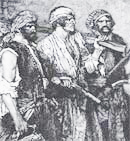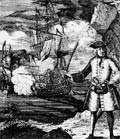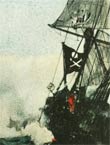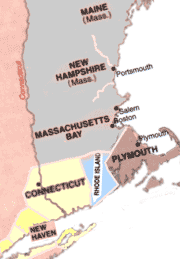Christ in the Colonies (1600 - 1700)
Buccaneers, Bigots, Slavers and Drug Traders
As the 17th century unfolded the eastern coast of North America became settled by a bizarre incongruity of theocratic colonies and the enclaves of pirates and slave traders. It gave birth to a uniquely American formula of violent criminality cheek by jowl with puritanical righteousness. In time the two extremes of dysfunctional human behaviour would feed off each other. The criminal, after a life of villainy, might find his salvation in religious rectitude and mortification. The theocratic tyrant, with access to wealth, power and women, would succumb to the blandishments of a carnal existence. Thus piety laced with corruption are as American as apple pie and turkey.
Jesus makes all things Bright and Beautiful
For the intrepid pilgrim it stiffened his spirit and described his role as the new Israelitein a second Land of Canaan, the native Americans scripted in as the lost tribes of Israel and therefore not without hope of redemption. For the Puritans who followed, it gave the reassuring certainty of patriarchal authoritarianism and the redemptory value of a life of toil and self-denial. Theirs was the joy of building a New Jerusalem in a heathen land. For the adventurers and the avaricious who arrived in ever increasing numbers it preserved group identity and sanitized every act of inhumanity and greed, for their triumph and conquest was Divine Will made manifest. It was all part of God’s plan, material success confirming His approval. For the weaker minds and the gentler spirits overwhelmed by the travails and brutality of unrestrained “enterprise” it offered the reassuring embrace of a guru who, in return, asked only for a little cash. And for the African slaves, imported by the hundreds of thousands to the plantations of hell, it offered consolation in their life of suffering, at one with Jesus, and the vain hope of a future kingdom in which they would “lay down their burden”. Hallelujah.
No Honour Among Thieves
About the same time as De Soto was raiding the southeast a compatriot, Francisco Coronado, tracked a small army through the southwest and reluctantly recognized that the Pueblo communities of the upper Rio Grande were too poor to conquer. The Spanish, disheartened that they had not found the “seven golden cities of Cibola”, concluded that the more northerly latitudes of the vast continent were of little value in their grande scheme of conquest and they concentrated on the rapacious exploitation of central and South America. Spain’s most northern settlement remained San Agustin in Florida, a fortress/port designed to protect the annual treasure fleet from irritating predators, lying in wait in bays around the Caribbean. For 300 years San Agustin remained simply an isolated military outpost.
Hit and Run: Buccaneers
But of course the line between villainy and patriotic heroics was finely drawn. Until late in the seventeenth century colonial governors issued “Letters of Marque” which gave a veneer of legality to attacks upon vessels and outposts of other nations. As so-called “privateers” adventurous mariners could make a legal killing (and kill legally) on the “pirate round” to the Eastern Sea (the Indian Ocean), where they could plunder or capture Moslem, Mogul or French ships with the King’s blessing.
Piracy in a frock coat
When blatant support for piracy brought on the unwelcome attentions of the British navy the pirate fraternity decamped to an island hideaway – New Providence in the Bahamas, a riotous pirate shantytown but even then, pirate services were sought as “privateers” to circumvent the British Navigation Acts.
Piracy in a frock coat
In any event, the French had beaten the English to the Americas and had established an early presence along the Mississippi and the St Lawrence rivers. This led the English (and the Dutch) to settle at other favourable harbours along the Atlantic seaboard and on the smaller islands of the Caribbean. Of the two, the Caribbean, with its immediate potential for hugely profitable sugar crops, supplemented by inter-island pillage, was the more important. Bermuda was settled in 1609, St Kitts and the Lesser Antilles between 1624-1628.
Jamestown 1607 – "Civilisation" arrives
Drug Money Saves the Day: Narconomics
The Commonwealth of Massachusetts
The Pure – Bigotry in a bonnet
Life under the American Taliban
A glimmer of light
Quaking and Shaking
Witches and Warlocks
Sources:
- J. Spiller, et al, The United States 1763-2001 (Routledge, 2005)
- Morrison, Commager, Leuchtenburg, The Growth of the American Republic (OUP, 1980)
- Sigmund Freud, The Future of an Illusion (1927)
- Russell Bourne, Gods of War, Gods of Peace (Harcourt, 2002)
- Douglas Butting, The Pirates (TimeLife, 1978)
- Richard Hart, From Occupation to Independence (University of the West Indies, 1998)
- Hugh Brogan, The Penguin History of the USA (Penguin, 1999)
- Francis Dillon, A Place for Habitation (Hutchinson, 1973)
- Phil Jones, Ralegh’s Pirate Colony in America (Tempus, 2001)
- Erroll Hulse, Who are the Puritans? (Evangelical Press, 2000)
- James Walvin, The Quakers, Money and Morals (John Murray, 1997)
- Susan Greenwood, The History of Early Witchcraft (Southwater, 2002)
Related Articles:

Puritans hang Quakers!
We Come in Peace



Something fishy
The French Connection



The English take liberties
Roanoke, Indian village


Jamestown, English village
The French Connection

Drug Trafficking Saves the Colony!


Dutch bargain
Biblical followers of fashion


Theocracy - 1650
Vigilant Pilgrims apprehend dangerous witch!


Drowned for Jesus – all in a day's piety
New York – named for Catholic Bigot

Pirate's Church


* Ergo ... Ergot
